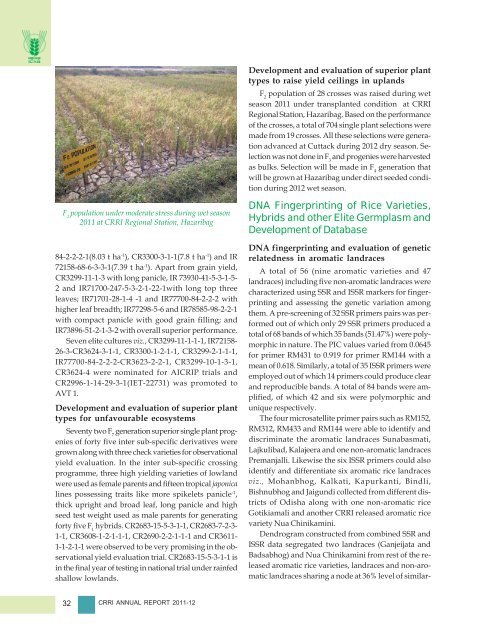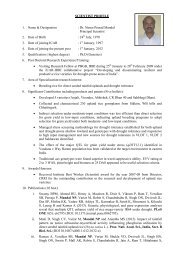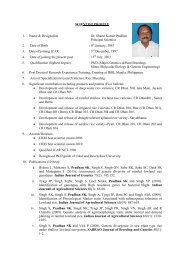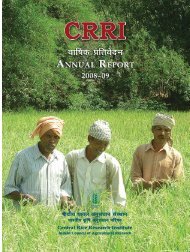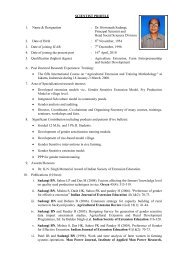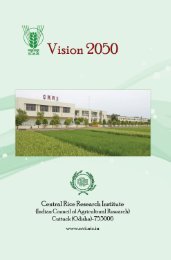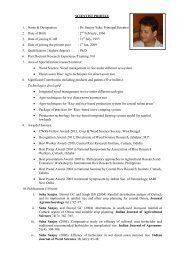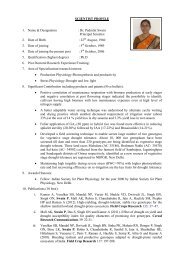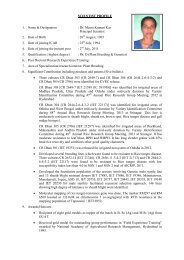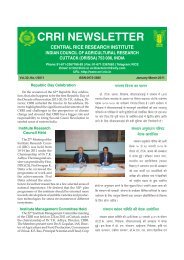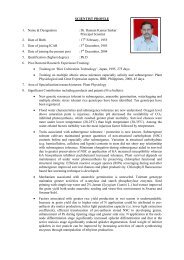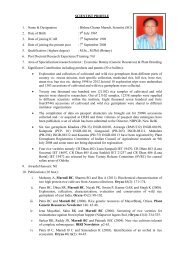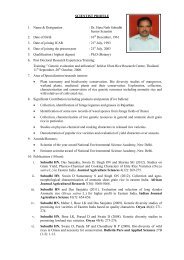Central Rice Research Institute Annual report...2011-12
Central Rice Research Institute Annual report...2011-12
Central Rice Research Institute Annual report...2011-12
Create successful ePaper yourself
Turn your PDF publications into a flip-book with our unique Google optimized e-Paper software.
Development and evaluation of superior plant<br />
types to raise yield ceilings in uplands<br />
F 2<br />
population of 28 crosses was raised during wet<br />
season 2011 under transplanted condition at CRRI<br />
Regional Station, Hazaribag. Based on the performance<br />
of the crosses, a total of 704 single plant selections were<br />
made from 19 crosses. All these selections were generation<br />
advanced at Cuttack during 20<strong>12</strong> dry season. Selection<br />
was not done in F 3<br />
and progenies were harvested<br />
as bulks. Selection will be made in F 4<br />
generation that<br />
will be grown at Hazaribag under direct seeded condition<br />
during 20<strong>12</strong> wet season.<br />
F 2<br />
population under moderate stress during wet season<br />
2011 at CRRI Regional Station, Hazaribag<br />
84-2-2-2-1(8.03 t ha -1 ), CR3300-3-1-1(7.8 t ha -1 ) and IR<br />
72158-68-6-3-3-1(7.39 t ha -1 ). Apart from grain yield,<br />
CR3299-11-1-3 with long panicle, IR 73930-41-5-3-1-5-<br />
2 and IR71700-247-5-3-2-1-22-1with long top three<br />
leaves; IR71701-28-1-4 -1 and IR77700-84-2-2-2 with<br />
higher leaf breadth; IR77298-5-6 and IR78585-98-2-2-1<br />
with compact panicle with good grain filling; and<br />
IR73896-51-2-1-3-2 with overall superior performance.<br />
Seven elite cultures viz., CR3299-11-1-1-1, IR72158-<br />
26-3-CR3624-3-1-1, CR3300-1-2-1-1, CR3299-2-1-1-1,<br />
IR77700-84-2-2-2-CR3623-2-2-1, CR3299-10-1-3-1,<br />
CR3624-4 were nominated for AICRIP trials and<br />
CR2996-1-14-29-3-1(IET-22731) was promoted to<br />
AVT 1.<br />
Development and evaluation of superior plant<br />
types for unfavourable ecosystems<br />
Seventy two F 7<br />
generation superior single plant progenies<br />
of forty five inter sub-specific derivatives were<br />
grown along with three check varieties for observational<br />
yield evaluation. In the inter sub-specific crossing<br />
programme, three high yielding varieties of lowland<br />
were used as female parents and fifteen tropical japonica<br />
lines possessing traits like more spikelets panicle -1 ,<br />
thick upright and broad leaf, long panicle and high<br />
seed test weight used as male parents for generating<br />
forty five F 1<br />
hybrids. CR2683-15-5-3-1-1, CR2683-7-2-3-<br />
1-1, CR3608-1-2-1-1-1, CR2690-2-2-1-1-1 and CR3611-<br />
1-1-2-1-1 were observed to be very promising in the observational<br />
yield evaluation trial. CR2683-15-5-3-1-1 is<br />
in the final year of testing in national trial under rainfed<br />
shallow lowlands.<br />
DNA Fingerprinting of <strong>Rice</strong> Varieties,<br />
Hybrids and other Elite Germplasm and<br />
Development of Database<br />
DNA fingerprinting and evaluation of genetic<br />
relatedness in aromatic landraces<br />
A total of 56 (nine aromatic varieties and 47<br />
landraces) including five non-aromatic landraces were<br />
characterized using SSR and ISSR markers for fingerprinting<br />
and assessing the genetic variation among<br />
them. A pre-screening of 32 SSR primers pairs was performed<br />
out of which only 29 SSR primers produced a<br />
total of 68 bands of which 35 bands (51.47%) were polymorphic<br />
in nature. The PIC values varied from 0.0645<br />
for primer RM431 to 0.919 for primer RM144 with a<br />
mean of 0.618. Similarly, a total of 35 ISSR primers were<br />
employed out of which 14 primers could produce clear<br />
and reproducible bands. A total of 84 bands were amplified,<br />
of which 42 and six were polymorphic and<br />
unique respectively.<br />
The four microsatellite primer pairs such as RM152,<br />
RM3<strong>12</strong>, RM433 and RM144 were able to identify and<br />
discriminate the aromatic landraces Sunabasmati,<br />
Lajkulibad, Kalajeera and one non-aromatic landraces<br />
Premanjalli. Likewise the six ISSR primers could also<br />
identify and differentiate six aromatic rice landraces<br />
viz., Mohanbhog, Kalkati, Kapurkanti, Bindli,<br />
Bishnubhog and Jaigundi collected from different districts<br />
of Odisha along with one non-aromatic rice<br />
Gotikiamali and another CRRI released aromatic rice<br />
variety Nua Chinikamini.<br />
Dendrogram constructed from combined SSR and<br />
ISSR data segregated two landraces (Ganjeijata and<br />
Badsabhog) and Nua Chinikamini from rest of the released<br />
aromatic rice varieties, landraces and non-aromatic<br />
landraces sharing a node at 36% level of similar-<br />
32 CRRI ANNUAL REPORT 2011-<strong>12</strong>


